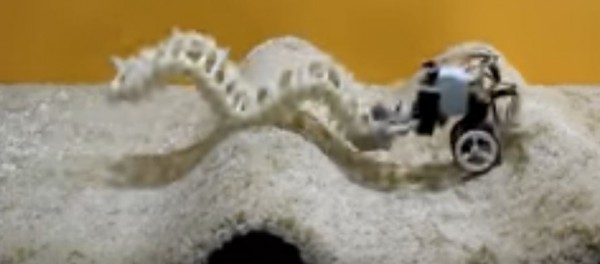By Krisana Estaura, | March 29, 2017

A team from the University of the Negev has invented a robot called SAW (single actuator wave-like robot) that can travel all the way into the small intestine in a wave-like motion. (YouTube)
An ingestible snake robot that could slither all the way through the small intestines could be used one day to check the digestive system visually.
Live Science reported that a team from the University of the Negev has invented a robot called SAW (single actuator wave-like robot) that can travel all the way into the small intestine in a wave-like motion. Its ultimate purpose is to carry a camera through the small intestine for colonoscopy. At present, only the large intestine is accessible to colonoscopy.
Like Us on Facebook
Lead inventor David Zarrouk noted that the robot has a 2D of crawling of a rotating helix as its external shape to enable a continuous moving wave. The direction it is moving can be reversed by simply reversing the direction of the motor.
Meanwhile, the entirety of the snake robot is made from a set of interlocking 3D- printed "plastic" pieces that resemble vertebrae.
As can be seen in the video below, the snake robot move very fast and is capable of slithering through a wide range of terrains, from water to rough, rocky soil.
Zarrouk said that his team initially created an inchworm-like robot that is capable of crawling through tight spaces. However, they found that it was not ideal for traveling through the serpentine length of the intestine.
The team, however, have three problems they need to solve before they could test the snake robot on living creatures.
First, the mock-ups were made from 3D printers and a plastic material that are deemed unfit for real-life applications.
Secondly, they have to ensure that the snake robot would not get stuck in the curvy portions of the intestines.
Lastly, the snake robot needs to climb upward at points where the intestines snake up.
TIME featured a modular snake robot from Robotics researchers at Carnegie Mellon University. It is, however, designed to address emerging problems such as performing surgery to inspecting pipes at nuclear power plants.
-
Use of Coronavirus Pandemic Drones Raises Privacy Concerns: Drones Spread Fear, Local Officials Say

-
Coronavirus Hampers The Delivery Of Lockheed Martin F-35 Stealth Fighters For 2020

-
Instagram Speeds Up Plans to Add Account Memorialization Feature Due to COVID-19 Deaths

-
NASA: Perseverance Plans to Bring 'Mars Rock' to Earth in 2031

-
600 Dead And 3,000 In The Hospital as Iranians Believed Drinking High-Concentrations of Alcohol Can Cure The Coronavirus

-
600 Dead And 3,000 In The Hospital as Iranians Believed Drinking High-Concentrations of Alcohol Can Cure The Coronavirus

-
COVID-19: Doctors, Nurses Use Virtual Reality to Learn New Skills in Treating Coronavirus Patients







